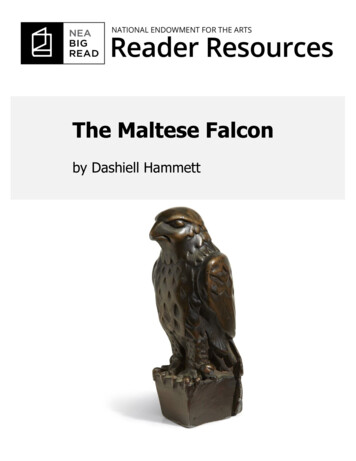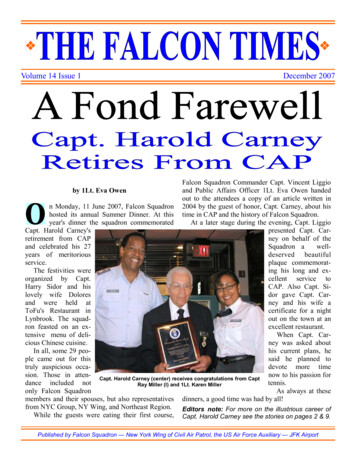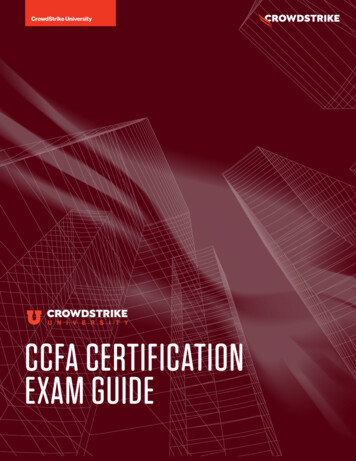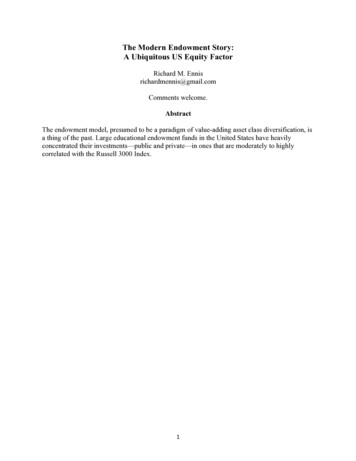
Transcription
The Maltese Falconby Dashiell Hammett1
Table of ContentsThe MalteseFalconAbout the Book. 3About the Author . 4Historical and Literary Context . 6Other Works/Adaptations . 7Discussion Questions. 9Additional Resources . 10Credits . 11PrefaceSome people were surprised when The Maltese Falcon, adetective novel, appeared on The Big Read list. Yes, it is adetective novel—one of the best ever written. It’s also abrilliant literary work, as well as a thriller, a love story, and adark, dry comedy. The only criticism one could offerHammett’s private-eye classic is that it is so much fun toread, it might be hard the first time through to realize howdeeply observed and morally serious it is.“I’m one of the few—if there are anymore—peoplemoderately literatewho take thedetective storyseriously.”What is the NEA Big Read?A program of the National Endowment for the Arts, NEA BigRead broadens our understanding of our world, ourcommunities, and ourselves through the joy of sharing agood book. Managed by Arts Midwest, this initiative offersgrants to support innovative community reading programsdesigned around a single book.A great book combines enrichment with enchantment. Itawakens our imagination and enlarges our humanity. It canoffer harrowing insights that somehow console and comfortus. Whether you’re a regular reader already or making upfor lost time, thank you for joining the NEA Big Read.NEA Big ReadThe National Endowment for the Arts2
About the BookIntroduction tothe BookThe Maltese Falcon is a bomb that starts ticking in the firstDashiell Hammett's third novel,The Maltese Falcon (1930), setthe standard by which allsubsequent detective fictionwould be judged. Hammett'sclean prose and sharp ear fordialogue produced anexceedingly readable novelwith enough twists to keep thereader turning the pages insearch of clues.Major Characters in the BookSet in San Francisco, the storytakes place over a six-day period, beginning Wednesday,December 5, and ending Monday morning, December 10,1928. A tough, independent detective, Samuel Spade ishired by the beautiful and mysterious "Miss Wonderly," whowalks into his office pleading desperately for help finding hersister. This bogus job gets Spade's partner, Miles Archer,and a thug named Thursby killed that same night. Thoughhe disliked Archer, Spade's personal moral code dictates that"when a man's partner is killed he's supposed to dosomething about it."The police question Spade's innocence because he andArcher's wife were having an affair. After Miss Wonderlysummons Spade to her hotel the next day, she confessesthat her real name is Brigid O'Shaughnessy. Spade knowshe's being manipulated but remains uncertain about Brigid'smotives.He returns to his office, where the shadowy Joel Cairo paysa surprise visit and offers five thousand dollars for the returnof a jewel-encrusted black bird.Spade soon realizes that O'Shaughnessy, Cairo, and Cairo'sboss, Casper Gutman, are all seeking an elusive falconstatuette once owned by the legendary Knights of Rhodes.Sam Spade is not a man to shy away from a fight, but he isalso clever enough to play along in order to find the falconand prove himself innocent.Who murdered Spade's partner? Where is the Maltesefalcon? Is Brigid O'Shaughnessy as guileless as she claims?Will Spade risk himself to save her? Among many otherthings, The Maltese Falcon is about what it's like to wantsomething—a fortune, a lover, or even respect—so bad thatyou would kill for it, give up a chance at happiness to get it,until finally the chase itself means more to you than whatyou're chasing.NEA Big ReadThe National Endowment for the Artschapter, ticks faster as it goes, and doesn't detonate untilthe last pitiless page.Sam SpadeCool and strong, grinning his way through his middle thirties,this cagey private detective becomes caught in a chase forthe falcon after someone guns down his partner, MilesArcher, in an alley. Spade's personal code drives him toavenge the murder-though whether from honor or just goodbusiness is for readers to decide.Miles ArcherTen years older than Sam Spade and none too bright,Spade's lecherous partner has never noticed his wife's affair.He misses the holes in an attractive new client's story, too,and pays dearly for it.Brigid O'Shaughnessy (aka Miss Wonderly)The consummate femme fatale, Brigid is beautiful,manipulative, and dangerous. A compulsive liar, she tries touse her feminine wiles to charm men into believing what shesays and doing what she wants.Effie PerineSam Spade's secretary is devoted and trustworthy, ifperhaps a little too trusting of Brigid. After Effie guards adead body for Spade, he compliments her loyalty and grit bysaying, "You're a damned good man, sister."Joel CairoA polished but imperfect crook, Cairo first offers Spademoney for the falcon, then holds him at gunpoint—twice—while searching his office.Casper GutmanCairo's corpulent employer describes himself as a man not"easily discouraged when he wants something." Hisobsession has led him on a seventeen-year search for thefalcon.WilmerGutman's sensitive young gunman has a smart mouth butnot much in the way of brains. As Spade observes, "Thecheaper the crook, the gaudier the patter."3
About the AuthorDashiell Hammett(1894-1961)It's possible that more peopleattended Dashiell Hammett'sbirth than his funeral. SamuelDashiell Hammett was born inSt. Mary's County, Maryland,on May 27, 1894, on thefamily farm called, with atouch of fateful poetry,Hopewell and Aim. Hammettgrew to be a solitaryteenager, quick to fight andhungry to read, a frequenterDashiell Hammett, 1932of libraries. The family's shaky (Courtesy of JosephineHammett)finances obliged him to quitschool at fourteen and go to work.In 1915 Hammett joined the Baltimore office of Pinkerton'sNational Detective Agency and subsequently filed threeyears of case reports, whose sparsely embellished stylecolored most everything Hammett ever wrote. WhenHammett joined the U.S. Army in 1918, he never got closerto World War I than Camp Meade, Maryland, where hedrove an ambulance until his tuberculosis led to anhonorable discharge. Hammett then resumed his Pinkertoncareer in Washington state, where TB eventually landed himback in a military hospital.There he met Josephine "Jose" Dolan, a nurse whose careproved so attentive that they moved to San Francisco andmarried in July of 1921. They welcomed their first daughterfour months later. In October 1922, after a year of scribblingat the San Francisco Public Library, Hammett sent H.L.Mencken a very short story called "The Parthian Shot" for hismagazine The Smart Set. The story was published,launching Hammett's career.From The Smart Set, Hammett soon graduated to detectivestories in the pulp magazine Black Mask about a namelessdetective. In time, self-contained stories gave way toinstallments of serial novels, which Hammett then reworkedinto the books Red Harvest (1929) and The Dain Curse(1929). He published The Maltese Falcon in 1930, moved toNew York, and wrote The Glass Key (1931) and The ThinMan (1934), his last novel.By 1934, Hammett was written out. Though he hadseparated from Jose five years before and begun a lastingaffair with the playwright Lillian Hellman in 1931, heremained a devoted absentee father to his girls in southernCalifornia.NEA Big ReadThe National Endowment for the ArtsMore and more, Hammett concentrated his energies onpolitics. He gave considerable sums of money to help fightfascism in Spain, co-published a magazine called Equality,and gave many political speeches. In 1942, he rejoined theU.S. Army during World War II as an unhealthy forty-eightyear old private and served three years in Alaska, editing thebase newspaper called The Adakian.But his military service didn't save him during the antiCommunist hysteria of the 1950s, when he spent six monthsin jail for contempt of court. Senator Joseph McCarthy evensucceeded in yanking three hundred copies of Hammett'sbooks from State Department libraries around the world,until they were restored by order of one highly placed fan:President Dwight D. Eisenhower.None of this persecution was good for Hammett's everprecarious health and finances. He died on January 10,1961, in a New York hospital. Hellman, his sister, and threecousins buried him three days later in the military cemeteryat Arlington, Virginia, roughly forty miles from his birthplaceat Hopewell and Aim.Hammett and Detective FictionThe invention of the detective story predates the inventionof the private detective by at least 2,500 years. If OedipusRex, the story of a Theban king on the trail of his father'skiller, isn't a story of detection, what is? But credit forcreating the first true detective probably belongs to EdgarAllan Poe (1809-1849), whose story "The Murders in the RueMorgue," pioneered the idea of a lone mastermind siftingclues and out-thinking everyone around him. The mostpopular fictional detective surely remains Sherlock Holmes,the London-based amateur sleuth created by Arthur ConanDoyle (1859-1930).Dashiell Hammett, first in his short stories for Black Maskand later in his novels, transplanted the genteel Britishdetective story to America and gave it an urban realism thatwould have baffled Conan Doyle or Agatha Christie. In the1920s and 1930s, Hammett wrote more than eighty shortstories and five novels. His crisp style and vivid slang createda gritty, street-level realism that registered strongly with thepublic.Often set in large, corrupt cities, Hammett's stories tend tofeature an independent-minded detective, a working man atodds with his violent society. His motivations—whethermonetary reward, a search for truth, or the preservation ofhis integrity—remain for the reader to decide.As Hammett's great successor Raymond Chandler wrote inhis fine, funny essay "The Simple Art of Murder," Hammett"took murder out of the Venetian vase and dropped it into4
the alley. [He] gave murder back to the kind of peoplethat commit it for reasons, not just to provide a corpse; andwith the means at hand, not with hand-wrought duelingpistols, curare, and tropical fish."In a phrase popularized by the great newspaperman DamonRunyon, a Hammett detective was "hardboiled":fundamentally a good egg, but far from soft. Hammett'sgenius lay in devising a style to match his masculine heroes.Even more than his heirs Chandler, James M. Cain, and RossMacdonald, Hammett never wasted an adjective, refining atightly visual vocabulary until everything inessential wasboiled away.NEA Big ReadThe National Endowment for the Arts5
Historical and Literary ContextThe Life and Timesof Dashiell Hammett1930s 1930: Hammett finishes The Glass Key and publishesThe Maltese Falcon.1890s 1894: Samuel Dashiell Hammett is born in Maryland.1900s Franklin Delano Roosevelt elected U.S. president,1932; Adolf Hitler becomes chancellor of Germany,1933. 1934: Hammett's last novel, The Thin Man, is inspiredand perhaps partly cowritten by Lillian Hellman. 1905: Tsarist soldiers kill hundreds of petitioners in St.Petersburg, helping light the fuse for the RussianRevolution of 1917. At age fourteen, Hammett quits school and bouncesfrom job to job, ending up at the famous Pinkerton'sdetective agency.1910s World War I begins in 1914; armistice signed onNovember 11, 1918. Hammett joins the U.S. Army in 1918, lasting onlyfour months before bronchial attacks lead to hisdischarge in 1919. 1919: Influenza outbreak subsides, after killing asmany as 100 million people worldwide.1920s 1920: The 18th Amendment, establishing Prohibition,becomes law. 1921: Hammett marries Josephine "Jose" Dolan, withwhom he soon has two daughters. 1922: Hammett leaves Pinkerton and starts writingstories for pulp magazine Black Mask. 1939: In detective fiction's greatest leap sinceHammett, Raymond Chandler introduces private eyePhilip Marlowe in The Big Sleep.1940s Japanese forces bomb Pearl Harbor in 1941; Americaenters World War II. The Axis surrenders, 1945. 1941: John Huston writes and directs The MalteseFalcon, starring Humphrey Bogart as Sam Spade. 1942: Hammett re-enlists in the U.S. Army, spendingmuch of World War II editing a base newspaper in theAleutian Islands. 1946: The Civil Rights Congress of New York electsHammett its president.1950s 1950: Senator Joseph McCarthy brandishes a list ofalleged Communists in the State Department,heralding the dawn of the Cold War. 1951: Hammett refuses to testify in court about hisCommunist associations; he is sentenced to sixmonths in jail for contempt. 1953: Dwight D. Eisenhower is inaugurated U.S.president, ushering in a period of economicprosperity. 1929: Hammett publishes Red Harvest and The DainCurse and writes The Maltese Falcon. 1929: Stock market crashes, triggering the GreatDepression.NEA Big ReadThe National Endowment for the Arts6
Other Works/AdaptationsHammett and His Other WorksLike many writers, Hammett came nearest to autobiographyat his career's beginning. In his first published story, "TheParthian Shot," Hammett featured a woman who leaves herfamily and heads west. When he wrote it in 1922, Hammetthimself had already moved from New York to San Francisco.Within a few years he would leave his own family, althoughhe'd continue to financially support his two daughters.After this early sketch, Hammett's next breakthrough came ayear later with the publication in Black Mask of "Arson Plus,"his first story about an unnamed Continental DetectiveAgency operative (known for short as "the Continental Op").Over the next few years, Hammett introduced severalelements all but new to detective fiction: realism, nihilism,fallible detectives, and slang—both overheard and invented.Selected Works by DashiellHammett Red Harvest, 1929 The Dain Curse, 1929 The Maltese Falcon, 1930 The Glass Key, 1931 The Thin Man, 1934 Crime Stories and Other Writings, 2001"The Big Knock-Over" (1927) was Hammett's longest storyyet, and soon he tried out a serial novel in Black Mask.Serialization gave Hammett the chance to work over thenovel twice, first in magazine installments, and later as thebook Red Harvest (1929). There he brought back "theContinental Op" as an amoral antihero, a loner who ridesinto a corrupt town and calmly goes about setting two rivalgangs at each other's throats.That same year brought another serial novel, The DainCurse (1929), in which "the Op" rescues a young womanfrom morphine addiction and no fewer than eight relatedmurder raps. This new chivalry showed Hammett chafingagainst the character limitations of his anonymous corporateoperative.Along with The Maltese Falcon, The Glass Key (1931)contains some of Hammett's best, toughest writing. Thestory of a political fixer's eventual disillusionment with hisboss, it's more of a gangster novel than a mystery.Hammett created perhaps his most romantic characters inThe Thin Man (1934): Nick and Nora Charles, twowisecracking socialites who investigate crimes betweenhighballs. Hammett dedicated The Thin Man to theplaywright Lillian Hellman, and a few have suggested thatHellman wrote more of it than he did.In fact, according to scholar Richard Layman, Hammettwrote more of Hellman's plays than she ever wrote of hisnovels. Hammett gave her the idea for her first Broadwayplay, The Children's Hour (1934), and worked closely withher on several others. As a novelist, though, despite severalfalse starts on a non-mystery called "Tulip," The Thin Manwould stand as Hammett's own premature parting shot.NEA Big ReadThe National Endowment for the Arts7
Hammett and the Falcon at theMoviesHollywood and The Maltese Falcon have at least this much incommon: They're each consumed with the pursuit of a foothigh golden statuette. Hammett probably deserved at least ashared Oscar for the 1941 movie, since most of its dialoguecomes straight from the book, but his only nomination camefor a different film years later. Even without The MalteseFalcon, Hollywood has Hammett to thank for more than afew good movies, and possibly an entire genre.would call his best work. Its script deservedly lost the Oscarto Casablanca (1942). Perhaps Dashiell Hammett's mosticonic monument rests in a place of honor at the CopyrightDepartment of the Library of Congress: a black bird,machined as a prop for The Maltese Falcon, made of leadbut worth its weight in gold.Filmmakers have adapted all of Hammett's novels at leastonce. Decades after Ben Hecht adapted Red Harvest asRoadhouse Nights (1930), Akira Kurosawa turned it into asamurai story in Yojimbo (1961), and Sergio Leone found init the makings of his first spaghetti western, A Fistful ofDollars (1964). Paramount had a crack at The Glass Key in1935 with George Raft and made it again in 1942, a bitbetter, with Alan Ladd. The Thin Man film series immortallypaired William Powell and Myrna Loy as Hammett's husbandand-wife crime solvers through one superior and severalinferior sequels. TV writer Robert Lenski turned The DainCurse into an eminently watchable 1978 miniseries, withJames Coburn miscast but well tailored as Hammett's"Continental Op."Nevertheless, just as Hammett's literary reputation rests onone book above all, his movie legacy rests principally on onepicture. John Huston adapted The Maltese Falcon (1941)with scrupulous fidelity to the book, knowing just where tocut and what to emphasize. He drew impeccableperformances from a dark, wounded Humphrey Bogart,somehow perfect as Hammett's blond Sam Spade, and allthe rest of his cast. It's a flawless movie, and film noir isunthinkable without it.Film noir is shorthand for those doom-laden, black-and-whitebut mostly black crime stories that suddenly appeared onAmerican screens in the 1940s. A few critics insist film noirstarted with an obscure, enjoyable Peter Lorre movie calledThe Stranger on the Third Floor (1940), whose script thenovelist Nathanael West helped write, but almost everybodyelse traces it to The Maltese Falcon (1941). This lineagemakes Hammett at least the godfather of every noir, fromDouble Indemnity (1944) to The Usual Suspects (1995),whose ending is unmistakably lifted by screenwriterChristopher McQuarrie from Hammett's great long story "TheBig Knock-Over."So what movie earned Hammett his Academy Awardnomination? Try Watch on the Rhine (1943), which he andLillian Hellman adapted from her play, and which nobodyNEA Big ReadThe National Endowment for the Arts8
Discussion Questions1.The Maltese Falcon centers on detective SamSpade, a character almost as elusive as the falconitself. What aspects of his personality remainmysterious? Which of his choices retain theirambiguity?2.Why does Sam Spade take the case, even thoughhe suspects that "Miss Wonderly" is lying?3.What kind of vision does The Maltese Falconpresent of urban America? How important is SanFrancisco as the novel's setting?4.The reader discovers some parts of the mystery atthe same time as the detective, and other partsmuch later. At what point did you solve the crime?5.Is Sam Spade a hero? How would you describe hispersonal moral code in a violent world?6.Why might Hammett avoid describing any of thenovel's murders in detail?7.What do the novel's three women—BrigidO'Shaughnessy, Effie Perine, and Iva Archer—havein common? How different are their personalitiesand motivations?8.In the 1930s and '40s mostly male writers adaptedthe femme fatale-a foxy, dangerous woman-tocrime stories. How might a woman have writtenBrigid differently?9.What motivates Sam Spade to find the falcon? Is hetempted by money or Brigid, or does he merely lovethe chase?10. Does any character change or grow in The MalteseFalcon?11. Are Sam Spade's actions in the novel's final sceneconsistent with his character? What would you havedone in his place?12. Although the reader is never privy to the thoughtsof Hammett's characters, what might the falconsymbolize to each of them based on their actions?NEA Big ReadThe National Endowment for the Arts9
Additional ResourcesResources on Hammett and TheMaltese Falcon Bruccoli, Matthew J., and Richard Layman.Hardboiled Mystery Writers: Raymond Chandler,Dashiell Hammett, Ross Macdonald: A LiteraryReference. 1989. New York: Carroll & Graf, 2002. Hammett, Jo. Dashiell Hammett: A DaughterRemembers. New York: Carroll & Graf, 2001. Johnson, Diane. Dashiell Hammett: A Life. NewYork: Random House, 1983. Layman, Richard, ed. Discovering The MalteseFalcon and Sam Spade. Rev. ed. San Francisco, CA:Vince Emery Productions, 2005. Layman, Richard. Shadow Man: The Life of DashiellHammett. San Diego: Harcourt Brace Jovanovich,1981. Layman, Richard, and Julie M. Rivett, eds. SelectedLetters of Dashiell Hammett. Washington, DC:Counterpoint, 2001. Nolan, William F. Hammett: A Life at the Edge. NewYork: Congdon & Weed, 1983.If you liked The Maltese Falcon, youmight enjoy: James M. Cain's The Postman Always Rings Twice,1934 Dorothy B. Hughes's In a Lonely Place, 1947 Raymond Chandler's The Long Goodbye, 1953 Ross Macdonald's The Chill, 1964 P. D. James's An Unsuitable Job for a Woman, 1972If you're interested in seeing otherclassic film noir, you might enjoy: The Stranger on the Third Floor, 1940 Double Indemnity, 1944 The Big Sleep, 1946 Kiss Me Deadly, 1955 Touch of Evil, 1958NEA Big ReadThe National Endowment for the Arts10
CreditsWorks ConsultedBruccoli, Matthew J., and Richard Layman, eds. HardboiledMystery Writers: Raymond Chandler, Dashiell Hammett,Ross Macdonald: A Literary Reference. 1989. New York:Carroll & Graf, 2002.Chandler, Raymond. "The Simple Art of Murder." AtlanticMonthly, December 1944: 57-58.Hammett, Dashiell. The Maltese Falcon. 1930. New York:Vintage Crime, 1992.Layman, Richard, ed. Discovering The Maltese Falcon andSam Spade. Rev. ed. San Francisco: Vince EmeryProductions, 2005.The National Endowment for the Arts was established byCongress in 1965 as an independent agency of the federalgovernment. To date, the NEA has awarded more than 5billion to support artistic excellence, creativity, andinnovation for the benefit of individuals and communities.The NEA extends its work through partnerships with statearts agencies, local leaders, other federal agencies, and thephilanthropic sector.AcknowledgmentsWriters: David Kipen (including "Hammett at the Movies")with Molly Thomas-Hicks and Erika Koss for the NationalEndowment for the ArtsCover image: The Maltese Falcon statuette. Copyright 2013 Bonhams & Butterfields Auctioneers Corp. All rightsreserved.Arts Midwest promotes creativity, nurtures culturalleadership, and engages people in meaningful artsexperiences, bringing vitality to Midwest communities andenriching people’s lives. Based in Minneapolis, Arts Midwestconnects the arts to audiences throughout the nine-stateregion of Illinois, Indiana, Iowa, Michigan, Minnesota, NorthDakota, Ohio, South Dakota, and Wisconsin. One of six nonprofit regional arts organizations in the United States, ArtsMidwest’s history spans more than 30 years.NEA Big Read Reader’s Guides are licensed under a Creative CommonsAttribution-NonCommercial-NoDerivatives 4.0 International License. Arts MidwestNEA Big ReadThe National Endowment for the Arts11
the Book Dashiell Hammett's third novel, The Maltese Falcon (1930), set the standard by which all subsequent detective fiction would be judged. Hammett's clean prose and sharp ear for dialogue produced an exceedingly readable novel with enough twists to keep the reader turning the










